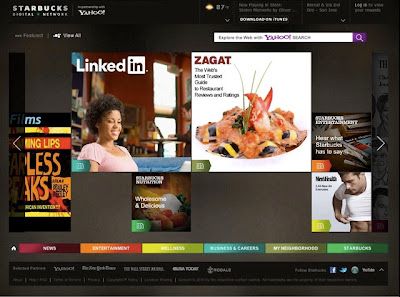
Beginning Wednesday, Starbucks customers who use the free Wi-Fi at more than 6,800 U.S. company-operated stores will be greeted with the Starbucks Digital Network (SDN) — an exclusive content network curated by the company and designed to enhance the customer’s in-store experience.
Starbucks has been teasing SDN for months, but now that the network is about to go live we have a much clearer idea about the type of content provided and the purpose behind the digital endeavor.
Starbucks’s Vice President of Digital Ventures Adam Brotman:
“The vision,” he says, “is for Starbucks Digital Network to be a digital version of the community cork board that’s in all of our stores.”
Here’s a comprehensive breakdown of each channel:
News: This section of SDN is comprised of Starbucks media partners offering premium or exclusive content to customers. The New York Times has opened up access to its Reader 2.0 subscription-based service for free, all content from the The Wall Street Journal is available minus the paywall and the exact replica of the USA Today newspaper is accessible to users on the network. Newly signed content partner GOOD is providing early access to its infographics, so Starbucks customers can view them before anyone else.
Entertainment: Starbucks has populated the entertainment portion of its network with music, apps and books from Apple’s iTunes, full access to a selection of books picked by Starbucks and provided by the Bookish Reading Club (via an HTML5 reader), business e-books courtesy of New Word City, a kid-rich experience powered by Nick Jr. Boost and handpicked documentary films provided by SnagFilms.
Wellness: Health and fitness publisher Rodale is the primary content provider for this SDN channel. Customers have access to specialized content — not available to anyone other than Starbucks customers — from Men’s Health, Women’s Health, Runner’s World, Bicycling, Prevention, Organic Gardening and Eat This, Not That!, along with a custom built “Map my Ride, Map my Run” application.
Business and Careers: Professional social networking site LinkedIn (LinkedIn) is making exclusive video and blog content available to Wi-Fi users in this channel. The network also provides LinkedIn job search and suggestions, and offers users a 30-day free trial for the premium account.
My Neighborhood: Starbucks is adamant about creating a localized experience to connect customers with the community around the store. The company delivers on this objective by serving up content to users based on the exact whereabouts of the store where the user is accessing the free Wi-Fi. Community fare includes local news from Patch and a look at nearby DonorsChoose.org classroom projects that could benefit from small contributions. Foursquare (Foursquare) users can check in via the web from Starbucks stores, and Zagat makes available full ratings for restaurants in the surrounding area for free.
Starbucks: This channel provides a personalized customer experience for Starbucks account/card management and also amasses all of Starbucks social (Twitter (Twitter)/Facebook (Facebook)/MyStarbucksIdea) and digital properties under one umbrella.

SDN certainly packs in a variety of content that makes for interesting material to explore on a laptop, but the network was also designed with the mobile user in mind.
Users accessing the network via mobile devices and tablets will benefit from the HTML5 smartphone-optimized network. SDN for mobile is also touchscreen-friendly, offering a hands-on, swipe-able experience.
More than 50% of users logging on to the free Wi-Fi are doing so from mobile devices, so the company was motivated by usage behaviors to build a mobile web experience just as good, if not better than, the standard web experience. Content was also designed to be “snackable,” so the mobile user can get value even while waiting in line, says Brotman.
Mashable



